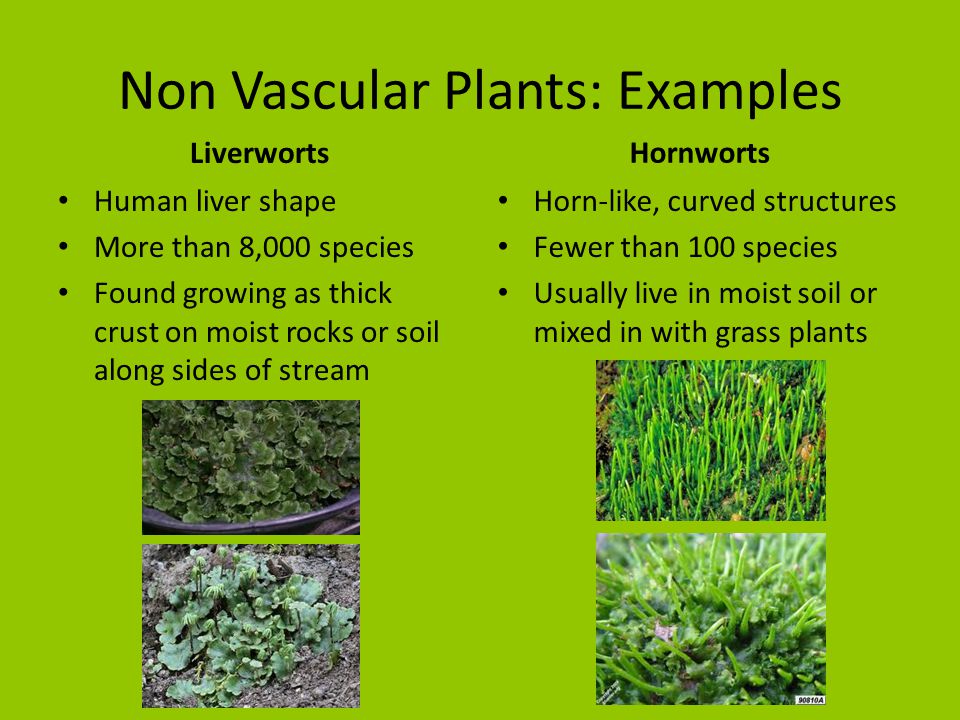
The vascular plants have tissues called xylem. Some examples of vascular plants include maize mustard rose cycad ferns clubmosses grasses etc.

Includes club moss Lycophyta horsetails Sphenophyta whisk ferns Psilophyta and ferns Pterophyta Name the 2 groups of seed-bearing vascular plants.
What are three examples of vascular plants. Roses are among the most beautiful and familiar examples ofvascular plants. Like other vascular plants a rose bush has rootsleaves and a network of vascular tissue running throughout theplant. The vascular plants are embryophytes which is a large clade or related group consisting of both non-vascular and vascular plants.
The embryophytes are further broken down into the Bryophytes including mosses liverworts and non-vascular plants and Tracheophyta. As the trachea in humans is a passageway for air the term tracheophyte refers to the vascular tissue in vascular plants. Common examples of vascular plants include trees shrubs grasses flowering plants and ferns.
Some examples of vascular plants include maize mustard rose cycad ferns clubmosses grasses etc. Some examples of non. Roots are the unaffected tissues derived from the stem of the plant.
The root is the part of the plant that grows down into the ground to get. The vascular plants have tissues called xylem. The xylem transports food and water to the tissues called phloem.
The xylem tissue is rigid. Vascular plants also known as tracheophytes forms the largest group of plants are defined as those land plants that have lignified tissues for conducting water and minerals throughout the plant. Ferns redwood trees celery grasses red oak treesGo here for photos and more.
Characteristics of Vascular Plants. 1-All vascular plants have roots usually a subway an aerial stem and leaves2-The tissues through which circulate nutrients mineral salts and water needed for the development of vascular plants are distributed throughout the structure of these3-Due to these vascular tissues these plants do not need a very specific environment to grow which means. Today only a few ground plants remain for the spore-producing vascular plant has been replaced by coniferous and deciduous seed plants.
Still present today are the spike mosses ferns horsetails club mosses and quillworts tiny reminders of the lush vegetation that once covered the earth. The nonvascular plants include the bryophytes while the vascular plants include the ferns gymnosperms and angiosperms see Chapter 19. The nonvascular plants have no internal transport system.
The vascular plants do have such a system and they are more structurally and functionally complex. Highly specialized tissues occur in the vascular plants. Subdivided into two groups – Seedless vascular plants and Seed-bearing vascular plants Name 4 divisions of seedless vascular plants and give an example of a plant in each group.
Includes club moss Lycophyta horsetails Sphenophyta whisk ferns Psilophyta and ferns Pterophyta Name the 2 groups of seed-bearing vascular plants. Any of various plants that have the vascular tissues xylem and phloem. The vascular plants include all seed-bearing plants the gymnosperms and angiosperms and the pteridophytes including the ferns lycophytes and horsetails.
Non-vascular plants or bryophytes include the most primitive forms of land vegetationThese plants lack the vascular tissue system needed for transporting water and nutrients. Unlike angiosperms non-vascular plants do not produce flowers fruit or seedsThey also lack true leaves roots and stems. Non-vascular plants typically appear as small green mats of vegetation.
Plants are relatively smaller in size when compared to non-vascular plants. Examples Examples of vascular plants include. Clubmosses grasses sunflower pines horsetails true ferns angiosperms and gymnosperms.
Examples of non-vascular plants include. Bryophyte mosses green algae liverworts and hornworts.